The bass guitar is a fundamental instrument in most musical genres and bands. They can take on multiple different roles, but the key to a great bassist is consistency and timing. A bass’s main function is to hold up the low-end in the mix and keep the band playing in a tight rhythmic pattern. They come in many shapes and sizes, but usually, they’re a larger, longer version of an electric guitar with either four or five thick strings. They are many types of bass guitars and we’ll cover each type in detail below.

We’ll also talk about the main differences between them and how to choose the right type for you. Let’s get into the list.
Table of Contents
Here Are the Types of Bass Guitars
1. Electric Bass Guitar
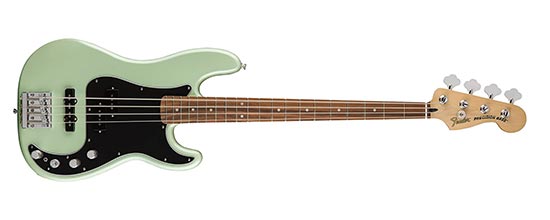
The 4 string electric bass is the most common type of bass guitar. However, 5 and 6 string models grew in popularity during the 1980s ever since there has been a plethora of 5 string and 6 string bass guitar models available. The additional string simply offers the player more low-end range. The first 4 high pitch strings are still tuned and played the same as a standard 4 string bass. If you are just starting out playing bass guitar, I suggest that you stick with a four-string bass, especially if you have no musical experience whatsoever. Just sticking with four guitar strings will keep your learning experience simple and less aggregating. There is still a whole range of notes and chords that you can play on four strings; most famous rock and metal bands have a bass guitar that only has four strings. Having fewer strings means that you have less to worry about when you’re performing live, which means that you can enjoy rocking out even more. Also, playing on a four-stringed bass guitar really will allow new musicians to refine proper playing techniques, as well as having the ability to develop a personal playing style.
On the other hand, if you have some musical experience, preferably with a bass guitar, you can upgrade to a five or six string bass guitar. Five strings will allow you to play more notes than the four string guitar, but the six string bass guitar will allow you to play the most notes out of all three options. Your fingers are going to have to do a lot more stretching around the neck of the guitar, which is going to take some practice, especially if you’re not used to laying a guitar with that many strings. If you’ve never played bass guitar, I would highly recommend that you start out with a four-stringed guitar. Even if you have experience playing an acoustic guitar or an electric guitar, learning bass guitar will be a brand new experience where you’re going to have to learn to shape and refine your playing techniques. Five and six string guitars are really great to use if you’re looking to specifically play metal, heavy metal, or rock. Having the extra string will allow you to reach all of those lower notes without having to spend any time de-tuning and re-tuning your guitar.
Is a five-string harder to play than a four-string?
Yes, a bass guitar is harder to play when it has more than four strings to play. You have more strings to keep control or, as well as more strings to memorize when playing without looking. A lot of beginners don’t realize that there’s a lot more work when you have five or six strings to play, instead of just four; you have more strings that you have to worry about keeping quiet, while also making sure that the strings you’re playing have the notes ring out. The more strings you have on a bass guitar, the closer the strings get, which makes playing certain styles like slap bass a lot more difficult.
The neck on the bass guitar will get wider and you have to have a higher accuracy rate; this means that you have to do more stretching and reaching on the neck of the bass with your fingers, which may be tricky if you have smaller hands. I always suggest that beginners start out with four strings because you can always switch up what you’re playing in the future, as switching from a four to six string isn’t too hard.
Popular Related Article: Top 14 Five String Bass Guitars
2. Acoustic Bass Guitar
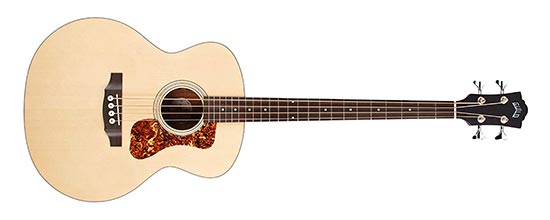
An acoustic bass has no electrics and pickups, in some cases they do but we’ll talk about that later. They are often preferred by unplugged players or beginners. There is no need to plug the guitar into anything to play it because the body produces a sound much louder than that of a standard electric bass when played without an amp. You simply pick up the bass and start playing. The main drawback is that the acoustic bass is not a very loud instrument, it can’t compete with a bass that is plugged into an amp, so as soon as you start to try to play with other musicians or if you simply play in a large venue with other people around, you can find that the sound from the guitar is quickly drowned out.
If you want a louder acoustic bass you should look out for the basses that have the largest bodies, as these will produce the most sound. The sound that an acoustic bass guitar makes is similar to that of the double bass and that’s why a lot of people love it. This means that the acoustic bass guitar can produce a resonant sound in the lower music registers. This is what makes the bass guitar different from a standard guitar, as it is much lower in pitch.
Understanding Acoustic Bass Guitars:
Usually, when people talk about bass guitars and the best bass players everything revolves around basses like a Fender Jazz or Music Man and the player who plays them. But you must now forget the acoustic bass which is an amazing instrument in my opinion and I love to play it. As a proud owner of fretless acoustic bass, I can’t tell you how much fun it is playing it.
Just as there are acoustic guitars, there are acoustic bass guitars. Acoustic basses are also completely different from their electric counterparts. With their unique tone quality, they can meld music in a different way than a standard bass guitar.
A lot of people see acoustic basses as a mix between an upright bass in terms of sound and electric bass in terms of playability. While not strictly true, we are quite satisfied with this definition for the time being. Most of the techniques that you can do on a standard basis can be utilized on the acoustic also so the range of possibilities is vast.
If you are looking for an acoustic bass guitar, you should ensure that you know all of the features that you want from it. Depending on the genre of music that you will be playing and your budget, not all guitars are likely to be suitable for you.
Acoustic vs Electric Bass:
There are many differences between an acoustic and electric bass guitar. Because a bass guitar has such a low register, they are quiet instruments. You need to really listen in order to hear the baseline. This is because the bass guitar is so low that our ears are not as well adjusted at picking up that sound.
If you choose an acoustic bass guitar, you should remember that it is very easy to drown out the sound when you are playing with other instruments or if you are in a room with many people. If you do want to play in a band, you really should consider purchasing an electric bass guitar, as he will be able to turn the volume up when you need to so that your instrument will stand out.
Some people prefer the look of an acoustic bass guitar. The traditional type of musical instrument does not come with any wires and there is something about the sound of an acoustic instrument that you just can’t replicate with an electric one. If you are only just learning to play the bass guitar, you may find more enjoyment in playing an acoustic than you would an electric bass guitar. If you are only playing your guitar at home to practice it, you will not really have any problems with the sound.
Another reason why a beginner may want to choose an acoustic bass guitar is that Electric bass guitars can be quite complicated to operate. If you are only just starting out, your main concern will be ensuring that you get your technique right. It can start to become very complicated if you need to work out what all of their control knobs and levers do.
Acoustic basses are also often the cheapest option. Even if sometimes acoustic and electric basses can cost the same, take into consideration that for electric bass in order to play it you need an amp which makes the investment quite bigger.
Why Buy an Acoustic Bass?
There are several reasons you should get an acoustic bass, although the biggest is the experimentation this instrument can offer.
The acoustic bass is a relatively new instrument in the music world. This actually appeals to many bassists, as they can experiment with playing new styles and techniques, without any preconceived ideas about what they should or should not be doing with it. Its qualities are similar to those of an upright bass.
One of the best perks of an acoustic bass is that you don’t need an amp and you can play it whenever. You can practice or bring it with you and jam with your friend anywhere. Because of the raw nature of acoustic bass, it’s a good instrument on which to perfect your technique. Your playing needs to be tight as it is not so easy to play as a well set up electric bass where your fingers just fly over the fretboard.
Playing an acoustic bass can help you develop how to use your picking hand correctly. As there is no pickup for you to rest your thumb on, you are forced to rest it on the E string or the body. That way you can develop the floating thumb technique which is very useful when you transition to electric bass.
Acoustic basses are great for performing unplugged as well as for practicing. When you are tasked with playing bass in an unplugged setting, you can now play on something with a familiar style, similar to electric bass.
Popular Related Article: 16 Bass Guitar Brands You Need To Know
3. Acoustic-electric Bass Guitar
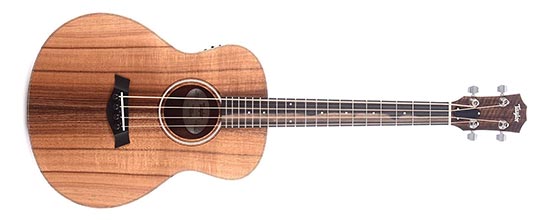
The good thing about acoustic basses these days is that they usually come with a set of electronics with them. Of course, they are awesome for playing unplugged gigs but this little feature can come in handy when doing other kinds of events. For example, if you are doing a gig with a couple of acoustic guitars these features come in handy because you would probably struggle with getting your sound out and end up hurting your fingers. With onboard electronics, you can match the output levels with different instruments.
Some basses come with rather simple electronics, while others feature more advanced systems. If you want to plug into an amp or PA system directly, a more elaborate preamp with more onboard tone-shaping capabilities comes in handy. You can find one that is going to suit your style.
If you like to meld your tone with different pedals a simple electronic system can get the job done for you.
4. Fretless Bass Guitar
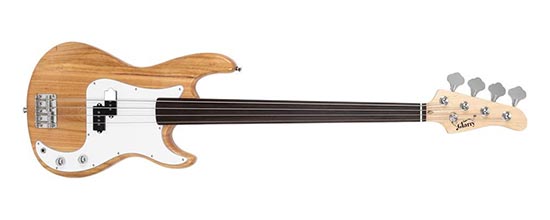
The first thing you are wondering if you are new to all this bass stuff is what is a fretless bass? It is pretty basic. A fretless bass has no frets over the fretboard, making the fretboard smooth. Frets are the metal wires up and down the neck of the bass beneath the bass strings. Their purpose is to accurately divide up the notes on each string when you press the string down. Without frets, it is up to the player to accurately find and play the notes up and down each string making sure they are in tune. Frets are used in modern western instruments like the bass or the guitar to create proper note intervals. The traditional Western chromatic scale has 12 tones from octave to octave, and that’s what you get with a fretted instrument.
The note played at the 12th fret is an exact octave of the open string, and all of the frets in between are placed to divide the string length to produce the remaining 11 semitones.
With a fretless bass, the limitation of having just those 12 tones available is eliminated and therefore granting you more possibilities when playing different musical styles. On a fretless, you can get all of the microtones that are ‘in-between’ the regular notes. You’ll find that playing one provides options for both sound and technique that you just can’t get from a traditional fretted bass. Many famous players such as Jaco Pastorious opted for a fretless bass because of its unique sound and capabilities.
Do I want fretted or fretless?
Playing fretless bass is at least a little more difficult than playing fretted bass. If you are buying your first bass, you probably don’t want a fretless bass unless you know for sure that’s the sound you’re after. It takes a good bit of extra practice to accurately play the notes on fretless bass. When you miss the notes or play sloppily you can sound pretty bad. This can frustrate many students.
If you do want to play fretless bass, consider that playing a fretted bass first can help you eventually play fretless bass better. By practicing for a while on a fretted bass, you will learn to hear notes played accurately in-tune. Then, when you switch to fretless, you will be able to mentally hear the notes better before you play them. That is what is required to play the fretless bass in-tune—hearing what you want to play in your head first and then matching it.
Some playing styles don’t work well on fretless bass. On a lot of fretless basses, it is difficult to get a good slap bass tone. (Slap bass is a percussive style of bass playing done by slapping the strings.) Tapping is a bit more challenging. (Tapping is done by striking the strings against the fingerboard without plucking the string.) And playing chords (several notes at the same time) in-tune can be really tricky. None of it is impossible, however.
If you’ve been playing bass for a while and are considering if a fretless will be easy to learn, a good way to judge is how easily you are able to tune your bass. If tuning accurately by ear is a struggle, you can guess tuning every note you play will also be some work.
Why would you want a fretless bass anyway?
The fretless bass has a different sound to it. It has a real warm singing quality to it. You can smoothly slide from note to note. Fretless bass has a lot of subtlety and nuance. Often you will hear the tone described with words like “mwah” or “growl”.
Some amazing fretless bass players are Jaco Pastorius, Michael Manring, Mick Karn, Les Claypool, John Giblin, and Percy Jones. Find some of their stuff to hear the sound and possibilities of a fretless bass. It’s a beautiful sounding instrument that is well worth the extra practice. But, in my opinion, it’s probably not a great first bass choice for most beginning bassists. It’s not nearly as popular as other bass guitar types.
Popular Related Article: Top 14 Fretless Bass Guitars
5. Long Scale Bass Guitar
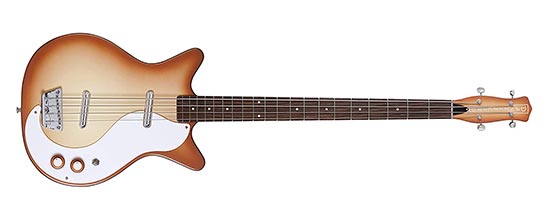
One thing to know when getting a new bass is the scale length. The scale length refers to the distance between the nut and the bridge. Why it’s important because it impacts the playability and the sound of the instrument in a big way. It affects the quality of the tone you get from the strings, the lower the pitch the longer the strings. The standard these days is 34” which we call “long-scale” basses but there are also short (30-32”), medium (32-34”), and extra-long (36” plus) scale basses. Not all scale lengths are the same and there aren’t any firm rules on this between bass and strings manufacturers so it’s definitely something you should pay attention to. A lot of players have a problem with choosing their strings lengths which is why you need to know your scale length.
Long scale bass guitars are the most common out there. Some of the most famous bass guitars such as the Fender Jazz bass use 34” scale length. 34” is a perfect scale length for many players, but you can always experiment and pick the one that suits you the best.
6. Short Scale Bass Guitar
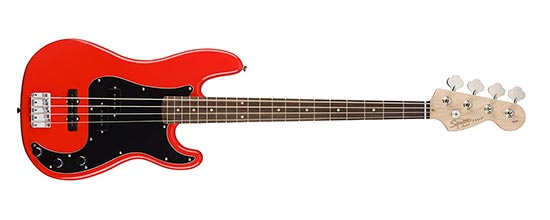
Do you know the phrase “good things come in small packages”? Well, there is nothing better than a nicely packed short-scale bass guitar. The bass is a wonderful instrument. It lays the foundation for other instruments in the band. But these days the bass is taking over, it is getting more and more popular and modern techniques are developing so fast professional bass players can get various sounds from them. There are so many different techniques and arrangements that can be done with the bass that justifies why so many musicians in the world love this instrument. Commonly disregarded for their long scale relatives in the bass family, I consider short scale basses to be some of the coolest instruments out there. People would usually go for a longer and bigger bass but let me tell you, these little basses pack quite a punch so don’t be fooled by their size and appearance. A regular bass guitar is designed to have a longer body and a heavier weight. Unfortunately, it is for that reason why some people may be turned off by learning the bass guitar. The short-scale bass guitar has its distinctive charms to offer. The shorter scale makes it easier for you to tune and play. Specifically, for people with shorter hands and beginner players that are younger, it’s a blessing.
So what does a short-scale bass offer except for better playability for people with shorter hands? While it is smaller and easier to play, short-scale basses can also produce peculiar tones that are different from what you may expect from standard scale-length bass guitars.
Difference between a short-scale and long-scale bass guitar:
In the early days of electric basses, some of Fender’s competitors like Gibson sold basses with shorter scale lengths. These more finger-friendly basses are referred to as “short-scale” because the scale length they have is 31″ or less.
One of the most recognizable short-scale basses back in the day was the Hofner Violin bass. Designed by Walter Hofner in 1955, had a 30” scale length and a signature violin shape. Craftsmen who were working for Hofner were used to building classical instruments and used their knowledge to design a bass that has that classical look to it. The Violin Bass became very popular when Paul McCartney from the Beatles started performing with it in the mid-’70s. Since then, it has remained a staple in the world of short-scale basses.
In the mid-’60s Fender also entered the short-scale business with the Mustang Bass, which attained a level of cult status after it went out of production in 1981. They restarted the production in 2002, but it gained steam again after Fender released a version in its Squier line in 2011. Since then it has remained in Fender’s permanent line-up with several configurations. The Fender’s Bronco Bass which was released in the mid-’60s was another short-scale option that never quite achieved the same reputation as the Mustang bass. The production was halted in 1981. However, the Bronco bass has recently found its way back into the bass game.
The main difference between the short-scale and the bigger long-scale is that people usually so the short-scale as a child instrument. That certainly dropped the short-scale bass’s cool factor, turning more serious players away from them and toward long-scale basses. There was a boom in the ’60s of short-scale basses but most of the instruments were poorly built, with bad electronics and hardware and that’s why many players avoided them, apart from the fact that they were aimed at the student market, so the short-scale bass earned a reputation as an instrument for children.
But now the short-scale bass guitar is back and cooler than ever and it’s one of the most common types of bass guitars out there. More and more players are choosing to go for the smaller basses that are equally built with quality parts and have a great sound like their bigger counterparts.
Why chose a short-scale:
The first and most obvious reason to use a short-scale bass is its physical size. With their shorter necks, less distance between frets, and more compact general dimensions, short-scale basses are an excellent choice for players with smaller hands. If you are a guitar player who wants to explore the bass they are perfect since their short-scale makes it feel like you are playing something in-between a bass and a guitar thus making the transition easier. However, you would choose an instrument just because of its size. One of the main things regarding the short-scale basses is the massive sound with a fat low-end you can get. Serious players and studio pros have long known this secret about short-scale basses.
A simple example of how the short-scale behaves differently than a long-scale, each note played on bass includes a series of harmonics that are predictable ratios of that note. These harmonics give an instrument its unique tone and feel so when the string length is shortened the tonal properties of those harmonics change.
This is easily demonstrated on any stringed instrument. For instance, play an E on the 12th fret of the low E string. Then, play the same note on the 7th fret of the A string. While the pitches are the same, the harmonics are different. The E played on the 12th fret of the low E string is darker than the E played on the A string, which is due to the shorter length of string resonating in that position. So, because of their reduced scale length, short-scale basses are inherently darker and, arguably, richer in tone than long-scale basses.
Another reason to choose a short-scale bass over a long-scale bass is its distinctive feel. Traditionally short-scale basses were equipped with the same string sets as long-scale basses but on a short-scale bass, the strings are under less tension because they are shorter. The strings have a looser, slightly “floppy” feel, which impacts the instrument’s feel, attack, sustain, and dynamics. For players looking for a tighter feel, many string manufacturers started developing strings that respond more like standard strings on a long-scale instrument. But, even with those strings, a short-scale bass retains its dark tone but with a more focused low-end.
Additionally, short-scale basses let you employ techniques that are difficult to pull off on long-scale basses. As the neck is more compact long stretches between notes that are far away are more manageable. The compact fingerboard is great for speedy, 16note-filled bass lines. Playing full chords is also much easier and poses no problem. Because of the more relaxed strings, you can bend the strings on a short-scale bass without crippling your fingers. All of this combined makes the short-scale playable and much wanted in the bass world.
7. Stand Up Bass Guitar
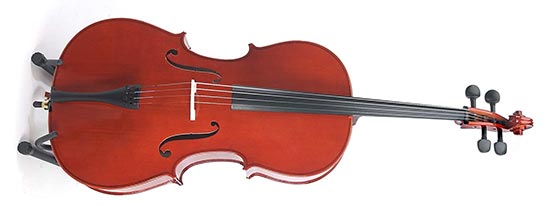
Double bass, also called stand up bass, is a stringed musical instrument, the lowest-pitched member of the violin family, sounding an octave lower than the cello. It has two basic designs—one shaped like a viol and the other like a violin. There are other designs, such as that of a guitar. It varies considerably in size, the largest normally being under 6 feet in total length. The body itself, without the neck, may be up to 4.5 feet for a full-size instrument, about 3.8 feet for a three-quarter size, and only slightly larger than a cello for the small chamber bass, or bassetto. A double bass is usually strung with four heavy strings pitched E A D G, a fifth string is occasionally added in jazz band basses, at the top of the register to allow high notes to be played more easily. In symphony orchestra basses, below the E string, tuned to C. Many basses, rather than having a fifth string, have a mechanical device with levers that increase the length of the fourth string. With this device, the pitch of the E string may be lowered or clamped to sound E when the lower notes are not needed.
Two styles of bass bow are currently used. The short and narrow French bow held palm downward, and the broader German bow, held palm upward. The double bass also can be played pizzicato, occasionally in symphonic orchestras and almost always in jazz and dance bands.
In jazz ensembles, the bass forms part of the rhythm section and is also used as a melody instrument. It is often electronically amplified when played with such groups. The electric upright bass is a slender instrument that is easier to transport and is also common. In most rock and some jazz bands, the place of the double bass is taken by the electric bass guitar.
Choosing the Right Bass Guitar (Features and Considerations)
Most bass guitars utilize four strings but sometimes five or even six strings tuned an octave below an electric guitar (EADGBE). At these low frequencies, the bass fills the low-end in a mix, making your music sound big and punchy.
I recommend starting with a four-string for their simplicity, but as you start to find your style, you might find an extra string or two works better for your technique or music. First, let’s take a look at all the parts that make up a bass guitar.
There are a lot of small details that make up a bass, all of which have an effect on its sound, durability, and playability. The most important part of buying any guitar is how it feels to play.
All basses have varied necks, bodies, and hardware. Once you’ve found a shape you like, buying basses in the future becomes easier. As I just mentioned you are not stuck with the hardware like pickups, bridge, machine heads, control knobs, or even pickguards that come with your guitar. These can all be changed out by any trained guitar luthier with either custom or off-the-shelf parts.
8. Hollowbody Bass Guitar
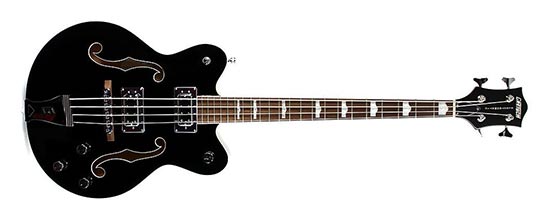
This type is hollow on the inside similar to an acoustic guitar, much lighter but also a greater chance of feedback. These bass guitars are usually incredible for unplugged playing and are somewhat lighter than their solid body counterparts. One of the most famous Hollowbody bass manufacturers is Hofner. They became well known when the Hofner Violin bass came out. One of the players that made Hofner famous was the legendary Paul McCartney who played the Hofner Violin bass.
There are also semi-hollow basses that are something in between a solid and a hollow body bass. The sound on these basses is warm and earthly. They offer great versatility in playing.
Bass Guitar Overview Guide
Body
The first thing you will notice on any bass is the body. Not only does it need to look great and suit the style of your band but it also needs to feel good in the hands. Every company has its own body shape but you can really break them up into 3 major categories. These are not really strict rules as you can get modern-styled basses fitted with J or even P bass hardware which will completely change the sound.
P-Bass
The P-Bass design is based on the Fender Precision Bass and is focused on being a simple to use instrument. Normally found with a single pickup and a smaller body. Perfect for Rock, Punk but also widely used in dub bass styles like Reggae.
J-Bass
The J-Bass design is based on the Fender Jazz Bass. This bass has a larger body normally with a pair of single-coil pickups and therefore a larger range of sounds compared to the P-Bass style. This is suited to pretty much any style where accuracy and subtlety are needed more than aggression.
Modern-style basses are normally fitted with soapbar or humbucking pickups with a large thick body. Brands like Fender, Ernie Ball, Ibanez, and Chapman Guitars make basses in this style that work really well for a wide range of styles although you will most commonly see them used with rock and metal players.
None of these bass styles are better or worse than any other. It all just comes down to exactly what you are playing.
Tonewoods Explained
Now, this is a complex subject and one that takes up a lot of time to explain but I will keep it brief here. Most basses you will find will either have an Alder, Ash, Mahogany, or Basswood body. Each of these different woods produces a slightly different sound depending on what kind of sound you are after.
Alder
Adler is considered to be the most balanced and versatile of any bass tonewood. That’s why you will often find it on basses that are focused more on versatility than one set sound. If you want one bass for any style check out Alder.
Ash
Ash is very similar to Alder tonally but it does have some slight differences. With Ash, you will generally get a bit higher-end and faster attack. These small differences make this the perfect wood if you are a slap player that also needs to play with a pick or fingers as well.
Mahogany
Mahogany is a deep warm wood that works brilliantly for picked and fingered styles that need to really hold up the low end in a mix. The main issue with mahogany is that it weighs a lot which when used on such a large instrument can make it a pain to play.
Basswood
Basswood is warmer than Alder but not as dark as Mahogany, Basswood has an interesting sound that you will either love or hate. It has a beautifully balanced sound but with a bit more low end to carry the mix. This is most commonly used on basses with active preamps as it lets you take advantage of that balanced sound.
Electronics
This is where things start to get a little complicated. Don’t worry, however, as I’ll quickly brief you on different types of preamps and pickups. Unlike most electric guitars, with bass, you can have an active preamp without having to use active pickups.
This means you have a wealth of different options available to you including some active systems, some passive, and others that mix together for the best of both worlds.
Preamps Explained
With an active EQ, the only limitation is how many controls are there. All active systems will be slightly different but most will contain at least 1 volume control, treble boost/cut, bass boost/cut, and if you have multiple pickups either a blend control or a second volume pot. Active electronics give you much more control over your sound from your guitar allowing you to not only cut but boost frequencies without having to touch your amplifier. This is great if you like to change sounds often and don’t want to fiddle with the amp. Active electronics do require a battery to run which will need to be changed out every few months to a year. And if you leave the bass plugged in, you’ll drain the battery.
Although not strictly a preamp, when it is passive the circuitry in the guitar, would act much like any other guitar you may have seen. Normally you would have at least 1 volume control and 1 tone control as well as possibly a blend control or second volume if you have multiple pickups. This system lacks control when compared to an active circuit but it does affect the tone. A lot of bassists prefer a passive system for a more natural rounded tone that works better for jazz, blues, and other similar styles.
Pickups Explained
Just like the electronics, the pickups come in active and passive forms but also different sizes and shapes. Each of these different pickup styles will drastically affect the tone and should be one of the most important parts of buying any bass. One of the things to keep in mind is that active pickups do require a 9v battery to run which will need to be changed every few months. Three main types of bass pickups can all come in different casings but there are three core designs. You have the split-coil P-Bass style pickup, the straight single coil J-Bass style pickup, and dual coil (humbucker) pickups.
Straight Single Coil
The Jazz style pickup is by far the most common type of single-coil pickup you will see as depending on your amplifier you can use these with pretty much any style. They will never sound quite as raw or fat as a P-Bass pickup though you do get a much clearer definition.
Split Coil
Normally used as the only pickup on bass or with a straight single-coil pickup in the bridge position. These pickups are loved by rockers for their tight, clear, and punchy sound that works well with high gain distorted guitars in a mix.
Dual Coil
Found on a wide range of different guitars these pickups don’t have the same humming issues that you get with single coils. They also produce a very large, round sound that works amazingly for some vintage rock style tones. Normally humbuckers will be found with an active preamp for a more diverse range of sounds.
Necks
Bass necks are an interesting subject as there’s nothing more subjective on a bass. It’s all about the feel that you prefer. While some will like the wider 70’s Jazz Bass style necks others may instead want to go for the thinner neck of an Ibanez.
Bass necks can be made out of any of a large number of woods each of which will produce a different feel and tone. The most common design is to have a Maple neck reinforced with either Walnut or Bubinga with either a Maple, Rosewood, or Ebony fingerboard. The only way to find the right neck for you is to get your hands on as many basses as possible until you find the right kind of shape.
Left-handed
Getting a left-handed bass is totally up to you, but it is not necessary just because you are left-handed. Many southpaws play right-handed basses with no problems at all. When you play bass both hands have to do work.
Consider the following: If you start playing left-handed basses, there will always be fewer bass guitars from which to choose. On top of that, it is always an extra $100 or more option on most basses whenever you want to buy a bass.
Generally, I recommend to new students who are left-handed not to buy left-handed basses. I can’t see any real advantage to them. No one makes a left-handed piano. If anything, by playing a right-handed bass when you are left-handed you may develop your own unique sound compared to right-handed players. The choice is yours, but don’t feel you have to buy a left-handed bass guitar just because they make them. You’ll be fine either way.

My name is Chris and I’ve had a passion for music and guitars for as long as I can remember. I started this website with some of my friends who are musicians, music teachers, gear heads, and music enthusiasts so we could provide high-quality guitar and music-related content.
I’ve been playing guitar since I was 13 years old and am an avid collector. Amps, pedals, guitars, bass, drums, microphones, studio, and recording gear, I love it all.
I was born and raised in Western Pennsylvania. My background is in Electrical Engineering, earning a Bachelor’s degree from Youngstown State University. With my engineering experience, I’ve developed as a designer of guitar amplifiers and effects. A true passion of mine, I’ve designed, built, and repaired a wide range of guitar amps and electronics. Here at the Guitar Lobby, our aim is to share our passion for Music and gear with the rest of the music community.

Nothing about the “Stick” bass. I want no weight on my shoulders and the freedom from the whole “body” of the bass. Disappointing…
simple explanation and very informative. My grandson who is in the Philippines requested for this Christmas an electric guitar. I’m doing my own research. My grandson plays the drum.